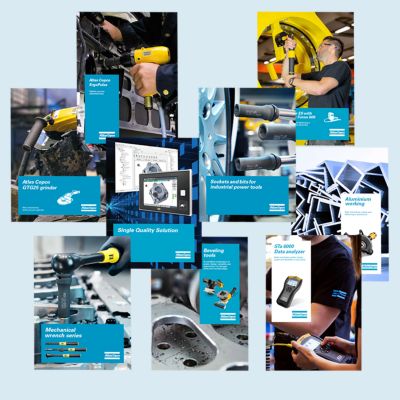In modern manufacturing, balancing sustainability goals with cost efficiency is more important than ever. Professional servicing of tools and equipment plays a key role in achieving this by enhancing productivity while also reducing the carbon footprint of manufacturing processes.
Preventive maintenance as an approach to enhance sustainability efforts
Preventive maintenance is a proactive approach that keeps production running smoothly and minimizes unexpected downtime. Unlike reactive repairs, modern preventive maintenance leverages real-time data and adaptive service intervals to not only improve efficiency but also support sustainability by reducing waste, lowering energy use, and extending equipment lifespan.
1. Environmental benefits: Reducing carbon footprint
- Preventive maintenance helps to reduce the environmental impact of industrial operations. By ensuring that tools work well, companies can reduce the need for rework and minimize unnecessary waste.
- Compared to tools without maintenance, properly maintained tools are less likely to have severe and unexpected breakdowns, reducing the demand for parts replacement. By taking a proactive maintenance approach, a top EU car manufacturer can reduce the replacement of spare parts and hence decrease CO2e emissions by 85% per year[1]. This, in turn, lowers the need for energy-intensive raw materials for new spare parts production, contributing to a more resource-efficient product cycle.
- Air leakage is another significant source of energy waste and inefficient production. Leaks cause air tools to lose power, forcing compressors to work harder and consume more energy. By properly maintaining airline infrastructure, manufacturers can improve tool performance, significantly cut energy consumption, and thus considerably reduce emissions. For example, after proper maintenance, a mid-size compressor (250 kW) can save extra energy consumption of 175 MWh per year[2], corresponding to around 50 tons of CO2e emissions. This is equivalent to the annual electricity use of about 54 average EU households[3].
[1] Based on Atlas Copco CO2 calculator and industry average assumptions.
[2] Based on airline audit at customers’ sites.
[3] Based on EU electricity and heat statistics, EU size of housing, and Greenhouse gas emission intensity of electricity generation.
2. Economic benefits: Operating cost efficiency
- Preventive maintenance is also cost-effective and can lead to big cost savings over time. Research showed that usage-based and condition-based maintenance can provide manufacturers 30% cost savings. The costs are saved from, among others, labor, downtime, and spare parts as issues are identified and resolved before they escalate into major, expensive repairs.
- Additionally, preventive maintenance extends the lifespan of tools. Studies have shown that preventive maintenance improves equipment reliability (consistently performing intended functions without breakdowns or failures) by 32%. Longer lifespan not only saves costs on equipment replacement but also aligns with the principles of circular economy, which focuses on maximizing the use of existing resources.
- Data-driven preventive maintenance programs can reduce energy consumption by 10-30%, delivering both environmental benefits and substantial cost savings on energy, which contributes to the financial sustainability of the business.
3. Social benefits: Cultivating a positive work environment
- Preventive maintenance also plays a vital role in enhancing workplace safety. Studies have shown that it improves workplace safety by reducing the risk of accidents and injuries from faulty equipment by 40%. This is especially important in industrial settings where equipment failures can lead to serious harm.
- A well-maintained work environment boosts employee morale and productivity. Workers are more efficient when they have reliable tools and equipment, fostering a positive workplace culture and leading to higher retention rates.

Committed to sustainability: SBTi
Atlas Copco is a signatory of the Science Based Targets initiative (SBTi) and is thereby committed to reduction of the greenhouse gas emissions in line with the 1.5°C Paris Agreement goal. This includes cutting emissions across the operations and supply chains, aligning business strategies with climate science, and regularly reporting progress.

Atlas Copco circularity program (pilot)
Our circularity program helps customers identify the improvement areas to reduce environmental footprint through repair, recycle, and refurbishmnent[4]. Once the tools and equipemnt reach end-of-life, we offer decommissioning services and recycle non-reusable parts in accordance with environmental regulations.
[4] Offered upon customer request and subject to component availability.
Do you know Atlas Copco CO2 calculator?

The CO2 calculator is an online tool offered to our customers to evaluate potential CO2 reductions by utilizing our proactive services and tool transformation methods. Our CO2 calculator leverages sophisticated analytics and statistical techniques for optimized results.
Conclusion
Professional servicing of tools and equipment is key to improving production efficiency and reducing the carbon footprint of manufacturing, helping manufacturers meet sustainability targets. Preventive maintenance programs help minimize breakdowns and failures, reduce downtime and waste, and extend the lifespan of tools - boosting efficiency, cutting costs, and lowering environmental impact. Real-time monitoring and data-driven services further support sustainable manufacturing. Together, these strategies benefit the environment, reduce costs, and enhance long-term competitiveness.









